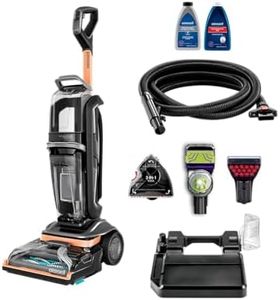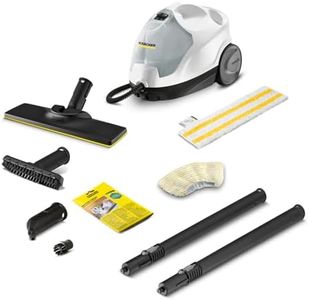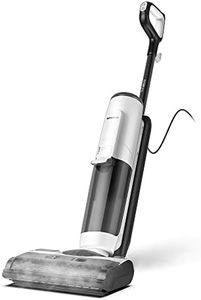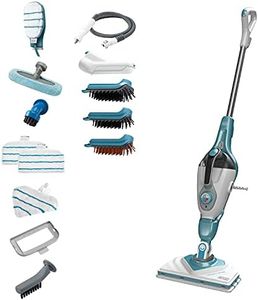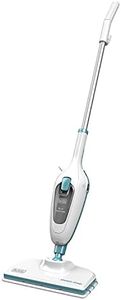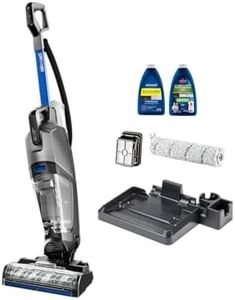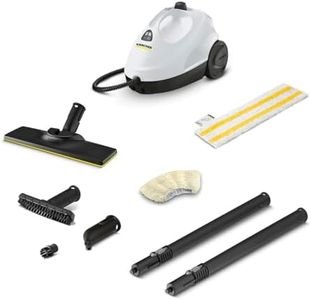We Use CookiesWe use cookies to enhance the security, performance,
functionality and for analytical and promotional activities. By continuing to browse this site you
are agreeing to our privacy policy
10 Best Steam Cleaners
From leading brands and best sellers available on the web.Buying Guide for the Best Steam Cleaners
When you're looking to buy a steam cleaner, it's important to consider what tasks you'll be using it for the most. Steam cleaners are great for deep cleaning and sanitizing various surfaces without chemicals, which makes them popular for use on floors, kitchens, bathrooms, upholstery, and even clothing. To choose the best fit, pay attention not just to power or looks, but to specifications that match your cleaning needs and the surfaces you have. Understanding the basic specs will help you make a confident choice that saves time and works effectively for your specific situations.Tank CapacityTank capacity refers to how much water the steam cleaner can hold at one time. This is important because it determines how long you can clean before having to refill. Smaller tanks (around 200–500 ml) are lighter and heat up faster, making them great for quick jobs or spot cleaning. Medium tanks (500–1000 ml) give a balance for most household uses, covering several rooms without being too heavy. Large tanks (over 1 liter) suit bigger homes or when cleaning large areas like floors but are heavier and take longer to heat. Consider how much cleaning you do at one time and choose a capacity that matches your routine.
Steam PressureSteam pressure is the force with which steam is expelled from the cleaner. Higher pressure helps remove tougher dirt and grime, making cleaning easier. Lower pressure (under 3 bar) is fine for delicate jobs like fabrics or light dusting. Medium pressure (around 3–4 bar) suits most general household needs such as cleaning kitchens and bathrooms. Higher pressure (over 4 bar) is best for deep cleaning stubborn stains, grout, or grease. Select based on whether you need gentle steam for light jobs or stronger steam for heavy-duty cleaning.
Heat-up TimeHeat-up time is how long it takes for the water in the tank to turn to steam and be ready to use. Shorter heat-up times (fewer than 3 minutes) are ideal if you want to clean quickly or do spot treatments. Longer heat-up times (up to 10 minutes) are common in bigger, more powerful machines. If you often clean in short bursts or want convenience, shorter heat-up time is better. If you're tackling big projects and don't mind waiting, longer times can be acceptable.
Continuous Steam TimeThis is the duration a steam cleaner can run without taking a break to refill the tank or let the machine recover. Shorter steam time (under 15 minutes) is enough for small tasks or quick fixes. Medium (15–30 minutes) handles most household cleaning in one go. Long steam time (over 30 minutes) is useful in larger homes or for cleaning many surfaces at once. Choose based on how much you clean in one session.
Attachments and AccessoriesAttachments are the different nozzles and tools that come with a steam cleaner, letting you clean a variety of surfaces. Fewer or basic attachments suit those who plan on using the cleaner for simple tasks like floors and counters. More specialized attachments, like brushes, squeegees, and upholstery tools, are helpful for cleaning windows, grout, fabrics, or tight spaces. Think about what surfaces and items you'll be cleaning, and make sure the cleaner comes with attachments that match those needs.
Weight and PortabilityThe weight and portability of a steam cleaner affect how easy it is to move around your home and use for different tasks. Lightweight models (under 2 kg) are easy to carry and work well for quick jobs or cleaning overhead areas like curtains. Medium weight (2–5 kg) balances portability and power, suitable for most households. Heavier models (over 5 kg) often have bigger tanks and more power, but might be harder to handle, especially on stairs. Consider your physical ability and the layout of your home when deciding.
Surface CompatibilityNot all steam cleaners are suited for every surface. Some are designed for hard floors only, while others can be used on carpets, upholstery, or delicate items. It's important because using a steam cleaner on an incompatible surface could cause damage. Check which surfaces you want to clean most—tile, sealed wood, laminate, fabric, or glass—and choose a model labeled safe for those. If you want to clean a wide range of items, opt for a versatile model with multiple settings or attachments.

